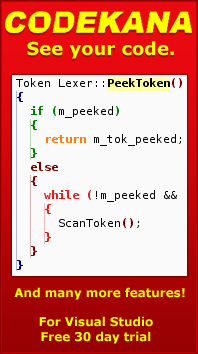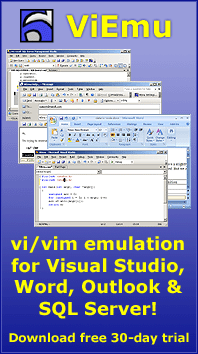I don’t want to start a flame war. I don’t want to advocate anything over to anyone. I’m just going to tell a little tale pertaining to my use of text editors.
About 6-8 months ago, I started doing most of my work on a laptop. I hadn’t used a laptop extensively, and I felt quite happy editing with UltraEdit (my editor of choice for years) or the built-in editor of Microsoft Visual Studio. Using VS to edit gives you Intellisense (a tooltip-box showing you the prototype of the function whose name you’ve just typed), a quick type-compile-correct cycle, and no time to start debugging.
You see, these laptops we have are nifty and all. Plenty of horsepower, decent screens, and you can use them on top of your lap at the sofa. There are only two quirks to me: one is that, if you add a mouse, you need a surface, which usually means a table, and a lot of the mobility is lost. The bag also starts to become bulky. The second quirk is that arrow keys, and even worse navigation keys (Home/End/PgUp/PgDn), seem to be an afterthought.
For the past ten years, I’ve never even thought that I was moving the hand across the keyboard to reach all these magic little keys hundreds if not thousands of times a day, and performing all sorts of selection/copying/pasting/navigation quickly. A common idiom: selecting the current line completely, and pasting a copy below it. I used to do that by pressing Home twice (as the first one gets you to the first non-blank character in the line and I want the whole line), then pressing Shift and holding it depressed while pressing the down arrow, then Ctrl-C, and then Ctrl-V twice (either that or Down-Arrow then Ctrl-V).
It’s more or less that. I must have made this action more times than I’ve said “hi”.
Now comes the wonderful world of laptop editing. There are many small variations of the laptop keyboard torture devised by different incarnations of Evil. Mine is an Acer with Del on the top-right corner (a good choice), Ins just left to it, the arrows in a nice little inverted T on the bottom right (not incredibly easy to find by touch, you see, I am a quite proficient touch typist as most people who spend a lot of their day typing).
The worst comes with the Home-End and PgUp/PgDn keys. PgUp and PgDn are dutifully struck there on the two little gaps of the inverted T – PgUp is above the left arrow, and PgDn is above the right arrow. This alone makes you unable to distinguish the inverted T shape by touch, which is such an aid for quickly locating it. And the mental cue of having PgUp above PgDn is lost. But the worst is yet to come: Home and End are the same two keys, as long as you press a difficult to press “Fn” key almost on the bottom left corner on the keyboard (second from the left, between the Ctrl and the Windows key).
This layout is incredibly uncomfortable. Such a simple idiom as I spoke about above turns into something like this:
– Move the hand around the bottom right corner trying to locate the keys
– Give up trying blindly and look down to locate them
– Try to locate Fn directly with the left thumb or little finger
– Give up and locate it either as the second key on the row or just look down
– Fn-PgUp (Home) twice
– Shift-Down, usually by touch from the previous position but w/o feeling reliable
– Ctrl-C (with which you lose track of where your left keys are)
– Ctrl-V twice
– Swear about these damn keyboards and try to remember what you were trying to write.
You see, a few days of this and I was bound to find a better solution.
I started thinking that there must be a way to edit text which didn’t require the Home/End/Arrow keys. I started dreaming up about text editing interfaces that would save all the hand movement. During one of those daydreams, it struck me: “remember vi, that old-school, bizarre, complex, text-editor?”. I had used vi (most probably vim) maybe a couple of times, once at the University HP-9000 Unix system and another time when installing Linux circa 1994. I promptly switched to “pico” or “joe” or one of the other more standard editors and forgot about it – not without learning that “i” helped you enter text (?!) and quitting required typing ‘:’ and then q or quit or e or exit or x or whatnot. The only way to add text to a line would be to use ‘a’ instead of ‘i’ while at the end of line, really weird But I had sometime heard that you DID NOT USE ARROW KEYS WITH VI. It resounded as a syren song in my mind. I commented it with a coworker, quite a Linux supporter, and he praised the vi input model really strong – no, he wasn’t using it most of the time having succumbed to development under Windows using plain Microsoft Visual Studio, but it was the best way of editing text known to man.
You see, I was perfectly happy with my editor(s), but suddenly the input model was a pain to use with my environment.
I looked up some resources, downloaded vim, and I started using it. First web page I printed out and kept at arm’s length for emergency:
Efficient Editing With vim – Jonathan McPherson
This is the best introduction to the vi input model I have found. First thing it does is tell you to stay away from the arrow keys and use h,j,k,l for moving around. Sure its weird, and I probably couldn’t have done it on a regular keyboard, but the laptop nightmare got me avoiding the arrow keys by sheer instinct.
It felt weird to have your hands stuck there in their home position. It felt even a bit “restrictive”, and things didn’t come out quick. It took about 2 weeks to become basically fluent with the vi model, and I was playing games of what commands to use for every little thing (“How do I erase this word? Oh, it may be, what key was it? ah, yeah, ‘b’, to go to the beginning of the word, then ‘d’ to delete and maybe ‘w’ to delete to the next word HURRAH! IT WORKED!” – then “diw – Delete Inner Word does it as well!”).
But after the steeeeeeeep learning curve, I started to become very proficient with it. You could split, resize and move around editing windows with just keyboard commands (“you mean, ‘k’ is up, but Ctrl-W and then ‘k’ gets you to the window above the current one? NEAT!”). Everything is there at your finger tips.
So – there I was, early 2005, discovering the input model of a text editor written, what, 25 years ago?, and finding out that it is the best input model for my current platform.
Mind you, once I’ve learnt it, it’s also much quicker to use on a regular keyboard – the incentive just wasn’t there with a fancy regular keyboard.
Now editing is no less comfortable at the sofa, on the plane or bus, than on a non-portable full size desk.
And do you know how I make an additional copy of the current line nowadays?
yyp
[Update May 31, 2006: if you want to learn vi/vim editing yourself, I think the best way to do it is the graphical tutorial I prepared recently. Enjoy!]


